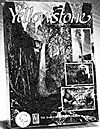
Designed by Joe Zarki and Jackie Golia
The Avalon Hill Game Company 4517 Harford Road, Baltimore, MD 21214
Released: July, 1985
Catalog No. 863 Price: $18.00
Complexity: Beginner
Solitaire Suitability: Good
***
Quick! What does the word Yellowstone bring to mind? The natural splendor of mountains, geysers, and wildlife? Garish tourists cluttering up campsites with their magenta Winnebagos? Or perhaps a debonair bear named Yogi slowly driving park rangers crazy?
Well, any one of these images could provide material for a game, especially the Toon-ish possibilities of the last one. But The Avalon Hill Game Company's new game, Yellowstone, is dedicated to a respectful, serious appreciation of the park. And while it's an attractively put together package, it falls short of its goal.
The game comes with a nicely done map board representing the summer and winter ranges of the variety of the park's native occupants. Counters are provided for Bison, Sheep, Elk, and Mule Deer, with different illustrations for male, female, and young. Food counters, predators (like the Coyote and Mountain Lion), and human hunters complete the ecological triangle.
Each player selects a herd, such as the Elk, and moves them from their winter range, across the board, to their summer range. Along the way, the herd can pick up food units (whose value is hidden until turned over) and dodge predators. Every turn includes a Seasonal Event where players roll on a random event chart that is keyed to the time of year.
These events can activate the predators who can prey on the herds. Some predators, like the Coyote, attack only the young or the injured, while the human hunter can attack any animal (unless he heads for a brewski binge at the local hot spot). The Seasonal Events chart lets players move active predators towards another herd and, quite naturally, away from one's own.
The four seasons are triggered by events on the board. Once one herd is in its summer range, then summer begins and it ends when all herds are in their summer range. Then, Fall starts and ends when all players have their herd (or what's left of them) inside their winter range. When winter begins, there's one roll on the Winter Seasonal Event chart and the game ends.
Players then fill out the scoring worksheet, a record of food units acquired and the needs of the surviving herd, to figure out the seasonal die-off Animal points, based largely on the surviving females and young, are computed. The herd with the most points wins the environmental sweepstakes.
The game is very well-balanced. The triggering of the seasons works nicely, and it's interesting to see the progress of the herd as it makes its way back to the winter range. Theres not much decision making in the game, though, as theres really only one direction to take your herd. The herd must move back and forth on the board, sharing a general movement point allowance and avoiding the occasional predator. In one game, the predators took residence in the hexes of my herd's summer range, tying up the next season (and slowing down the game).
Because of the automatic quality of play (not unlike the instinctive movement of a real herd), playing the game is not all that much fun. But the game does a good job of simulating the key points in the migratory life of Yellowstone's residents--the seasonal movement, the roll of predators, the ever-present spectre of death in winter, and the importance of the females and the young.
Yellowstone, with its realistic feel, would be a fine addition to a school's game library The general game player, though, is not likely to be interested.
Yellowstone is authorized by the National Park Service and the designers, Joe Zarki and Jack de Golia, are year-round rangers at the park. Their love of the park shows through quite clearly. They include in the game a 48-page "Gamer's Guide to Yellowstone" filled with stunning photos of the park's natural wonders, from a geyser shooting up into the ice-blue sky to a weasel scrounging around for a free lunch. Beautifully produced, this guide makes the Yellowstone map board and counters come to life.
While not destined to be a game sensation, Yellowstone is an attractive, informational package. It's one that parents and schools should consider buying.
More Adult Game Reviews
- Game Review: A Question of Scruples
Game Review: Toxins
Game Review: Yellowstone
Game Review: Big Time Wrestling
Game Review: 13: The Plus-Minus Card Game
Game Review: Illuminati Expansion Set 3
Back to Table of Contents -- Game News #11
To Game News List of Issues
To MagWeb Master Magazine List
© Copyright 1986 by Dana Lombardy.
This article appears in MagWeb (Magazine Web) on the Internet World Wide Web.
Other military history articles and gaming articles are available at http://www.magweb.com